Choosing the right log management tool can save your team hundreds of hours and thousands of dollars while preventing critical outages. Yet many organizations struggle with expensive proprietary solutions or complex open source setups that drain engineering resources.
This guide compares 10 powerful open source log management tools, analyzing their capabilities, performance benchmarks, and real-world deployment scenarios. Whether you're a DevOps engineer managing Kubernetes clusters or a software architect planning observability infrastructure, you'll discover practical solutions that match your technical requirements and budget constraints.
By the end of this article, you'll understand which tools excel at log collection versus analysis, how to avoid common deployment pitfalls that cause system failures, and which solutions provide the best performance-to-cost ratio for your specific use case.
Understanding Log Management: Collection vs Analysis
Before discussing individual tools, understanding the fundamental distinction between log collection and analysis helps you architect effective logging pipelines:
Log Collection involves gathering logs from distributed sources - applications, containers, infrastructure components, and cloud services - into a centralized location for processing and storage.
Log Analysis enables teams to query, visualize, and correlate log data to identify patterns, detect anomalies, troubleshoot issues, and gain operational insights.
Some tools specialize in one area, while others provide complete end-to-end solutions:
| Tool | Log Collection | Log Analysis | Complete Solution |
|---|---|---|---|
| SigNoz | ✅ | ✅ | ✅ |
| Graylog | ✅ | ✅ | ✅ |
| Logstash | ✅ | ❌ (limited) | ⚠️ (requires additional tools) |
| FluentD/Bit | ✅ | ❌ | ❌ |
| Syslog-ng | ✅ | ❌ | ❌ |
| Grafana Loki | ✅ | ✅ (via Grafana) | ✅ |
| Vector | ✅ | ❌ (routing only) | ❌ |
| Logwatch | ❌ (basic parsing) | ✅ (basic reports) | ⚠️ (minimal capabilities) |
| OpenSearch | ❌ (storage only) | ✅ | ⚠️ (requires ingestion layer) |
Understanding this distinction helps you build logging architectures that match your operational requirements and team expertise.
Top 10 Open Source Log Management Tools in 2025
1. SigNoz - Unified Observability with Advanced Log Management
SigNoz combines logs, metrics, and distributed tracing in a single platform, addressing the fragmented tooling that creates operational overhead and increased costs for modern engineering teams.
Key Strengths:
- Unified Observability: Correlate logs with metrics and traces for faster root cause analysis and comprehensive system understanding
- OpenTelemetry Native: Future-proof architecture with vendor-neutral telemetry collection and no lock-in concerns
- High Performance: Columnar database delivers up to 2.5x faster queries than Elasticsearch while using 50% fewer resources
- Advanced Query Builder: Intuitive interface for complex log filtering, real-time log tailing, and structured JSON/table views
- Easy Deployment: Simple Docker Compose or Helm chart setup gets you operational within minutes
Log Collection & Analysis: SigNoz uses the OpenTelemetry Collector for native log ingestion from any source, while also supporting existing log forwarders like FluentD, Fluent Bit, and Logstash. The platform provides powerful log querying capabilities with custom quick filters on key log attributes such as serviceName, deployment environment, and Kubernetes metadata.
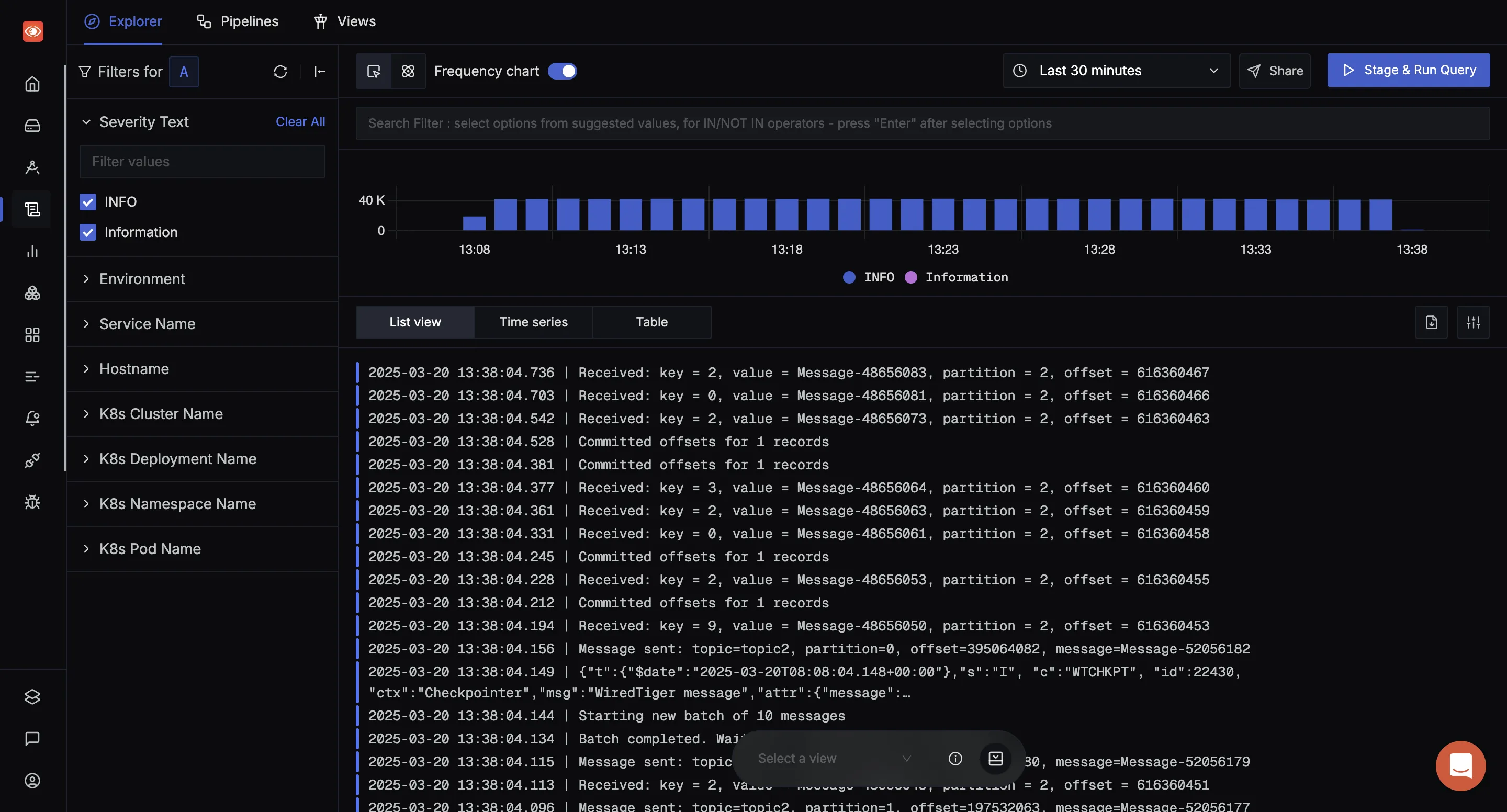
Advanced Features:
- Real-time log streaming and live tail capability for immediate debugging
- Custom quick filters that can be saved and reused for faster log analysis
- Log correlation with distributed traces for complete system visibility
- Robust alerting with dynamic thresholds and integration with Slack, PagerDuty
- API keys for automation of alerts, dashboards, and Terraform deployments

The query builder allows you to construct complex filters using AND/OR logic, making it easy to drill down into specific issues or patterns across your distributed systems.
Best For: Teams seeking unified observability, cloud-native architectures, and organizations wanting to avoid vendor lock-in with OpenTelemetry standard adoption.
Performance: Handles high-volume log ingestion with efficient storage and sub-second query performance on large datasets.
2. Graylog - Enterprise-Grade Log Management Platform
Graylog is a comprehensive log management solution designed for centralized log collection and analysis. Built on a multi-component architecture with Graylog server, Elasticsearch/OpenSearch, and MongoDB, it provides enterprise-grade features for security monitoring and compliance.
Key Strengths:
- Complete Solution: End-to-end log management with collection, processing, storage, search, and visualization
- Powerful Search: Leverages Elasticsearch's full-text search with an intuitive web interface
- Stream Processing: Real-time log categorization and sophisticated processing pipelines
- Enterprise Security: Advanced alerting, user management, and compliance features
- Content Packs: Pre-built configurations for common log sources to accelerate deployment
Architecture & Performance: The multi-component setup requires careful configuration but provides excellent scalability:
- Ingestion Rate: Aim for ≈ 30–60 k logs per second per Graylog node on modern hardware; pushing higher typically needs heavy tuning or extra nodes.
- Multi-component Setup: Graylog server orchestrates while Elasticsearch handles storage and MongoDB manages metadata
- Query Performance: Milliseconds to seconds depending on dataset size and hardware configuration
- Storage Overhead: 2-4x raw log volume for full indexing capabilities
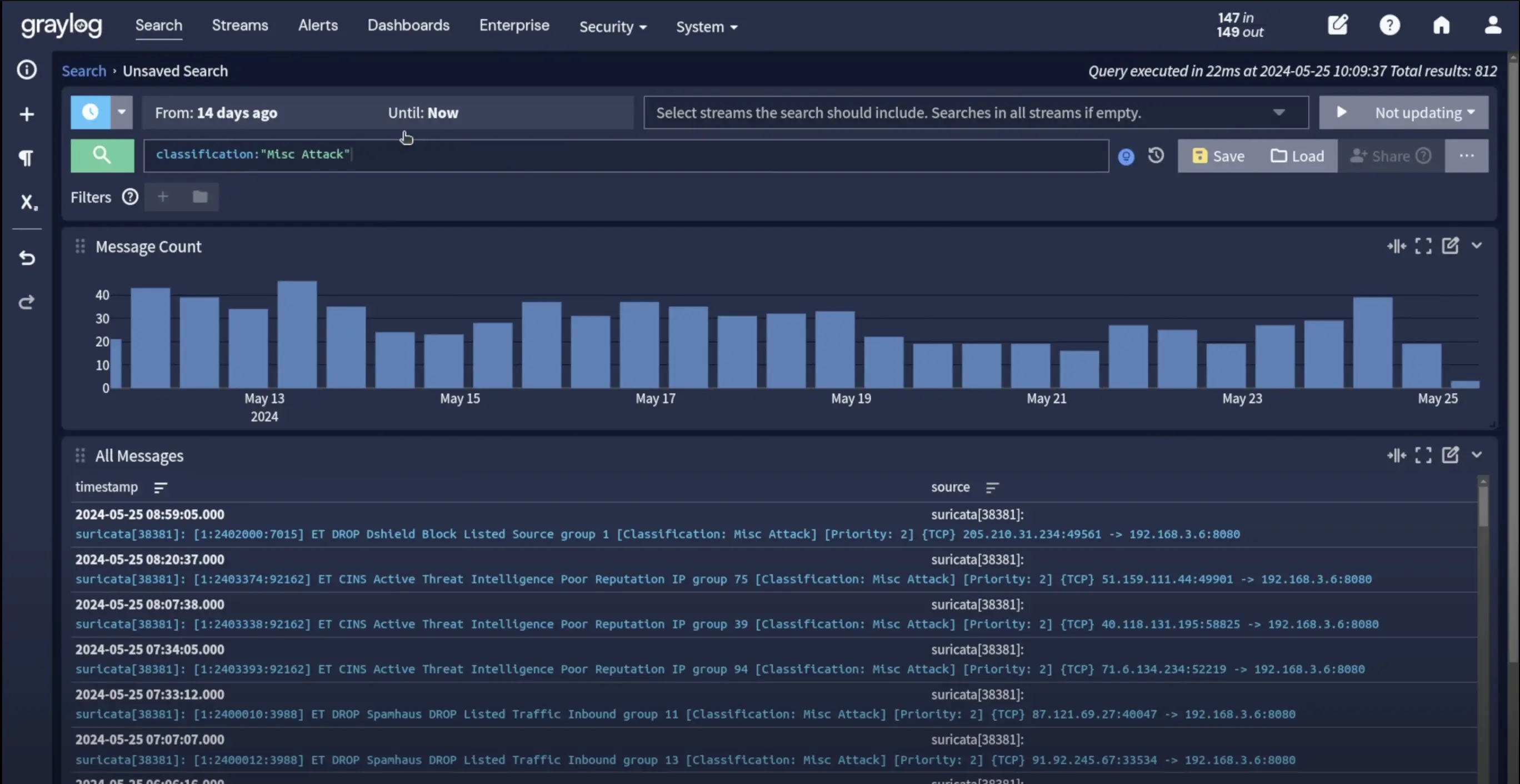
The Graylog interface provides extensive search capabilities with saved searches, stream processing rules, and detailed dashboard visualizations.
Notable Challenges:
- Complex multi-component architecture requiring expertise to manage
- Resource-intensive deployment with significant infrastructure requirements
- Potential storage bottlenecks if Elasticsearch isn't properly tuned
Best For: Enterprise environments requiring comprehensive log management, security teams needing detailed audit trails, and organizations with dedicated operations staff.
3. Grafana Loki - Label-Based Log Aggregation
Grafana Loki revolutionizes log management with its unique label-based indexing approach. Instead of indexing full log content like traditional solutions, Loki indexes only metadata labels, dramatically reducing storage costs and operational complexity.
Key Innovations:
- Label-Based Indexing: Only indexes metadata (labels) rather than full log content, reducing index size by up to 10x
- Cost-Effective: Significantly lower storage and operational costs compared to full-text indexing solutions
- Prometheus Integration: Shares the same label model as Prometheus for seamless metrics-logs correlation
- Cloud-Native Design: Horizontally scalable with excellent object storage integration (S3, GCS, Azure)
- LogQL Query Language: Prometheus-like query syntax for familiar log analysis
2025 Updates: Loki 3.0 and later versions introduced significant improvements:
- Bloom Filters: Experimental query acceleration for faster text string lookups, though performance varies by use case
- Native OpenTelemetry Support: Simplified ingestion and querying of OTLP logs without separate exporters
- Enhanced Kubernetes Support: Better pod metadata labeling and service discovery through Grafana Alloy
Performance Characteristics:
- Ingestion: Millions of log lines per second in production Kubernetes clusters
- Storage Efficiency: 10x cost reduction compared to full-content indexing
- Query Performance: Highly dependent on label specificity - fast for label-filtered queries, slower for arbitrary text searches
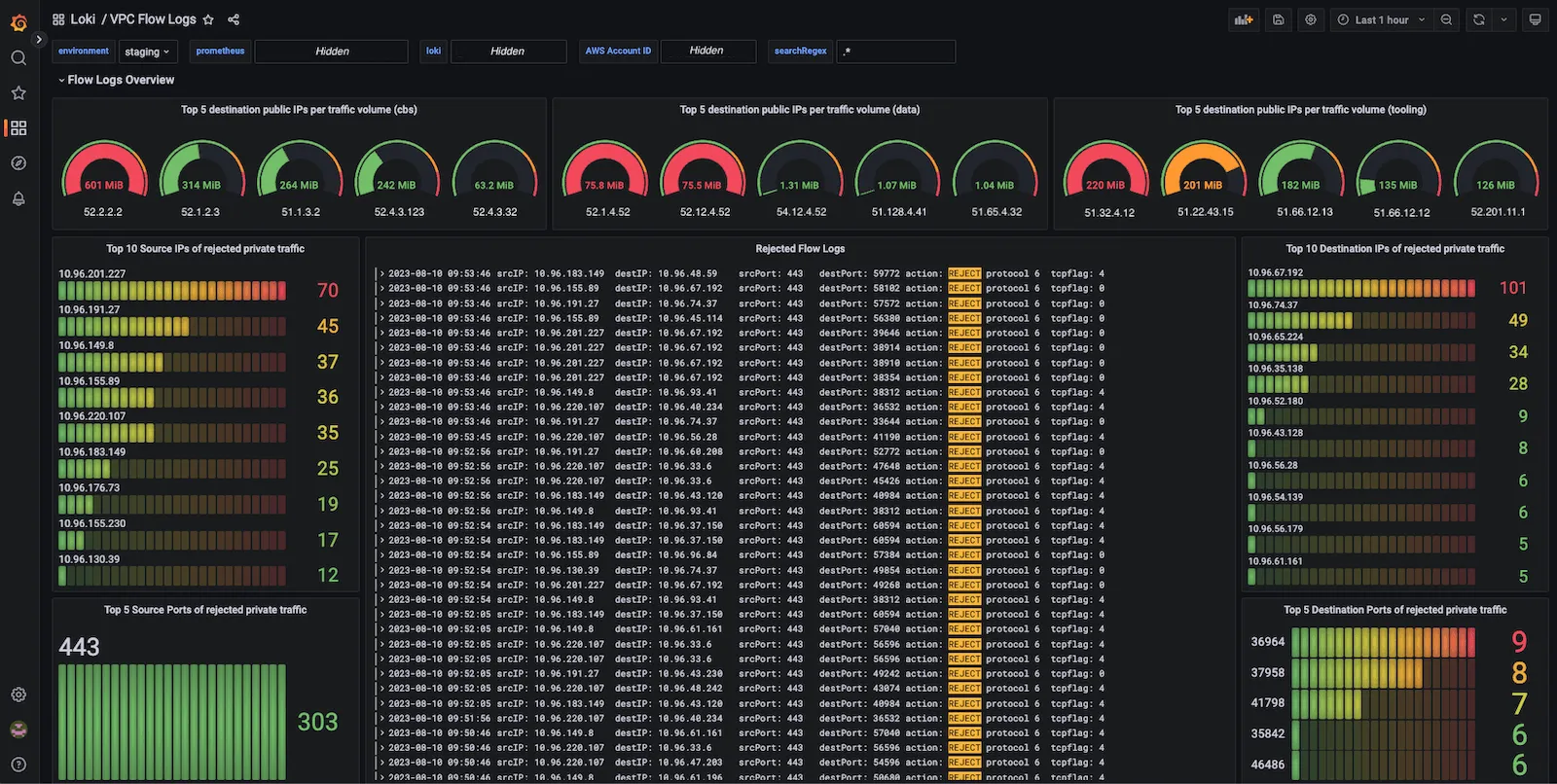
This interface shows how Loki integrates with Grafana for visualization, providing a familiar environment for teams already using Grafana for metrics monitoring.
Trade-offs:
- Reduced capabilities for complex full-text search across all logs
- Requires well-labeled logs for optimal performance
- Best suited for structured logging practices
Best For: Kubernetes environments, cost-sensitive deployments, teams already using Grafana ecosystem, and organizations with structured logging practices.
4. ELK/OpenSearch Stack - Comprehensive Search and Analytics
The ELK Stack (Elasticsearch, Logstash, Kibana) and its open source alternative using OpenSearch represent the most mature and feature-rich approach to log management. This modular architecture provides maximum flexibility and powerful analytics capabilities.
Key Components:
- Elasticsearch/OpenSearch: Distributed search and analytics engine for log storage and querying
- Logstash: Data processing pipeline for log transformation and enrichment
- Kibana/OpenSearch Dashboards: Visualization and analysis interface
- Beats: Lightweight data shippers for log collection
Key Strengths:
- Mature Ecosystem: Proven at massive scale with extensive plugin support (500+ plugins)
- Full-Text Search: Powerful search capabilities across entire log content with complex queries
- Rich Visualizations: Advanced dashboards, charts, and data exploration tools
- Flexible Architecture: Horizontal scaling at each layer with customizable data pipelines
- Machine Learning: Built-in anomaly detection and pattern recognition capabilities
Performance & Scale: The ELK stack scales well when properly configured:
- Ingestion: Variable but highly scalable - can handle terabytes of data daily
- Query Performance: Sub-second on properly indexed data
- Resource Requirements: Can become resource-intensive and operationally complex
- Storage: Full indexing overhead but provides maximum search flexibility
Common Deployment Challenges:
- Complex multi-component architecture requiring expertise
- Resource-heavy operation especially Elasticsearch clusters
- Storage capacity planning is critical
- Upgrade compatibility issues can disrupt operations
Best For: Organizations needing maximum search flexibility, complex analytics requirements, and teams with dedicated Elasticsearch expertise.
5. FluentD & Fluent Bit - Cloud-Native Log Collection
FluentD and Fluent Bit form the backbone of cloud-native log collection, providing a unified logging layer that decouples log producers from storage backends. As CNCF-graduated projects, they're widely adopted in Kubernetes and microservices environments.
FluentD vs Fluent Bit:
- FluentD: Full-featured log collector with 500+ plugins and moderate resource usage (~40MB memory)
- Fluent Bit: Lightweight, high-performance log shipper optimized for edge and containers (~4MB binary)
Key Strengths:
- Cloud-Native Design: Excellent Kubernetes integration with automatic service discovery
- High Performance: Fluent Bit processes hundreds of thousands of events per second with minimal resources
- Flexible Routing: Sophisticated log routing, buffering, and transformation capabilities
- Wide Adoption: Used by thousands of organizations with strong community support
- Protocol Support: Supports multiple protocols and formats for maximum compatibility
Operational Model: These tools typically deploy as DaemonSets in Kubernetes environments:
- Collect logs from all nodes automatically using service discovery
- Route logs to multiple destinations simultaneously (Elasticsearch, Loki, cloud services)
- Handle backpressure and buffering gracefully during downstream outages
- Enrich logs with metadata including Kubernetes labels and annotations
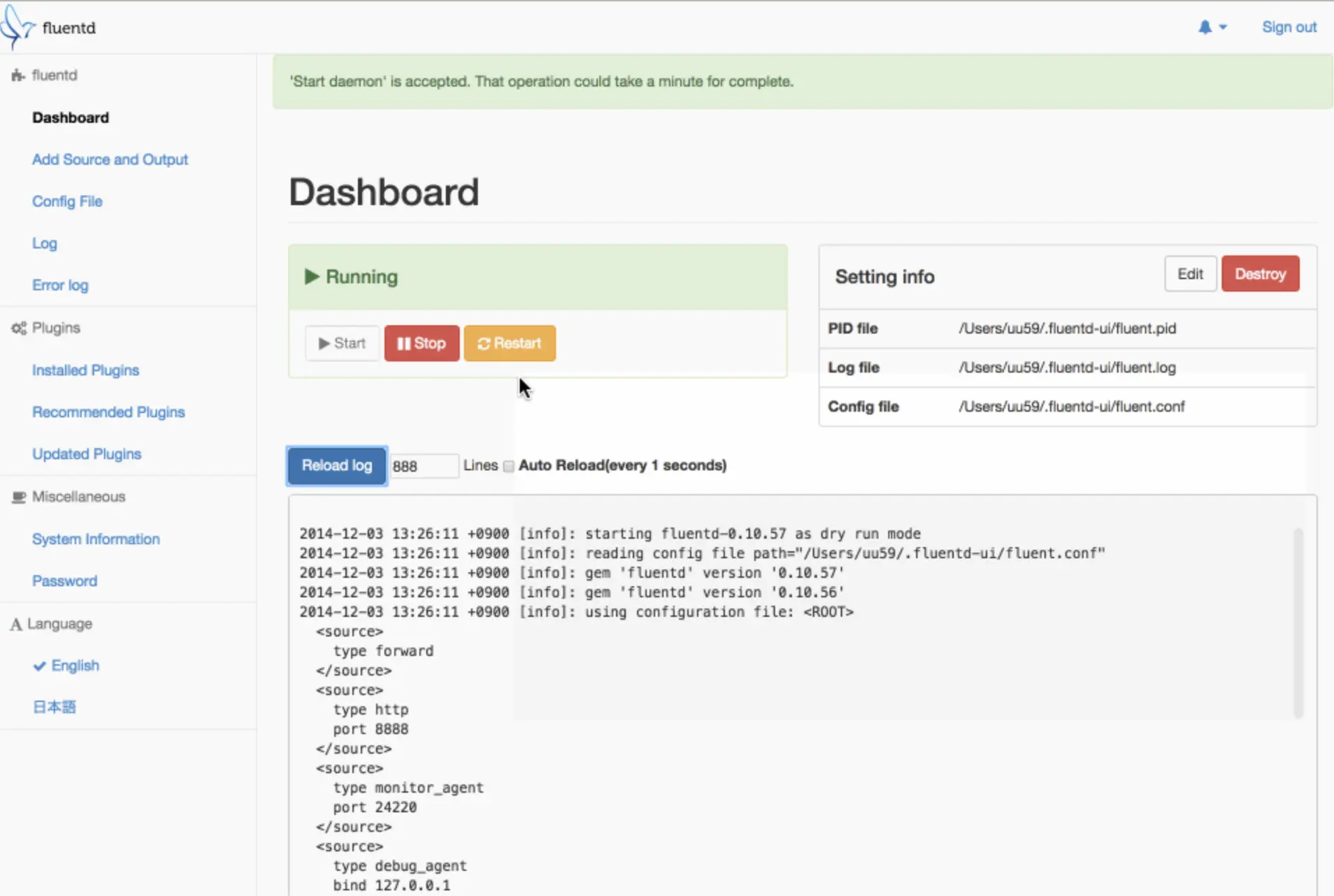
This configuration interface demonstrates how FluentD manages complex routing logic for different log sources and destinations.
Performance Metrics:
- Throughput: 100+ MB/sec log processing
- Resource Efficiency: Minimal CPU and memory footprint
- Scalability: Proven at 50,000+ server deployments
Limitations:
- Focus purely on collection and routing - requires separate storage and analysis backends
- Configuration complexity for advanced routing scenarios
- Limited built-in analysis capabilities
Best For: Kubernetes deployments, microservices architectures, edge computing, and organizations needing flexible log routing.
6. Logstash - Powerful Log Processing Engine
Logstash serves as a robust data processing pipeline that forms the "L" in the ELK stack. It excels at collecting logs from diverse sources, transforming them through configurable pipelines, and outputting to multiple destinations.
Key Strengths:
- Rich Processing Capabilities: Powerful data transformation using Grok patterns for parsing unstructured text
- Extensive Plugin Ecosystem: Hundreds of input, filter, and output plugins for maximum integration flexibility
- Reliable Delivery: Persistent queues ensure zero data loss during processing and downstream failures
- Real-time Processing: Stream processing with configurable buffering and batching
- Integration Flexibility: Works beyond just Elasticsearch with databases, message queues, and cloud services
Processing Capabilities: Logstash excels at complex data transformation:
- Grok Patterns: Advanced pattern matching for parsing complex log formats
- Field Manipulation: Add, remove, and transform log fields dynamically
- Data Enrichment: Lookup external data sources and add contextual information
- Conditional Logic: Route and process logs based on content and metadata
Performance Considerations:
- Resource Requirements: JVM-based with higher memory/CPU needs than lightweight alternatives
- Throughput: Handles high-volume processing but requires proper tuning
- Scalability: Horizontal scaling through multiple instances behind message queues
Common Deployment Patterns:
- Part of ELK stack for comprehensive log management
- Standalone for log transformation and routing
- Behind Kafka or Redis for high-availability processing
- Multiple pipelines for different log types and processing requirements
Limitations:
- No native visualization interface - requires Kibana or similar tools
- JVM overhead compared to newer native alternatives
- Configuration complexity for advanced transformations
Best For: Organizations already using Elastic Stack, complex log transformation requirements, and teams needing reliable data processing pipelines.
7. Vector - High-Performance Observability Data Pipeline
Vector represents a modern, high-performance observability data pipeline built in Rust. It's designed to collect, transform, and route logs, metrics, and traces efficiently in cloud-native environments.
Key Strengths:
- Exceptional Performance: Rust-based implementation delivers superior performance and memory efficiency
- Unified Data Pipeline: Handles logs, metrics, and traces in a single tool
- Memory Safety: Rust's memory safety guarantees prevent crashes and data corruption
- Rich Transformations: Advanced data processing capabilities with scripting support
- Vendor Neutral: Works with any observability backend without lock-in
Performance Characteristics: Vector's Rust foundation provides significant performance advantages:
- High Throughput: Processes millions of events per second with low latency
- Resource Efficiency: Minimal memory and CPU usage compared to alternatives
- Zero-Copy Processing: Optimized data handling reduces resource overhead
- Horizontal Scaling: Designed for distributed deployments
Transformation Capabilities:
- VRL (Vector Remap Language): Purpose-built language for data transformation
- Built-in Functions: Rich library of functions for parsing, enriching, and routing data
- Conditional Routing: Sophisticated routing logic based on data content
- Schema Validation: Ensure data quality and consistency
Best For: Performance-critical environments, organizations consolidating observability pipelines, and teams requiring advanced data transformation capabilities.
8. Syslog-ng - Enterprise Log Collection and Forwarding
Syslog-ng provides mature, high-performance log management that extends traditional syslog capabilities with modern features for enterprise environments. It particularly excels for network device logging and legacy system integration.
Key Strengths:
- High Performance: Capable of processing hundreds of thousands of messages per second on properly configured hardware
- Reliability: Disk-based buffering ensures zero log loss during network or downstream failures
- Flexible Routing: Sophisticated message classification and filtering for complex environments
- Security Features: TLS encryption, message signing, and secure storage capabilities
- Protocol Support: Extensive support for various log transport protocols and formats
Enterprise Features:
- High Availability: Clustering and failover capabilities for mission-critical deployments
- Compliance Support: Features for regulatory compliance and audit requirements
- Integration: SQL database output, message queue integration, and cloud platform support
- Management: Centralized configuration and monitoring capabilities in enterprise versions
Performance & Reliability:
- Throughput: High sustained throughput capabilities depending on hardware and configuration
- Buffer Management: Persistent disk buffers prevent data loss
- Memory Efficiency: Optimized for high-volume processing with modest resource requirements
- Network Resilience: Handles network outages and downstream failures gracefully
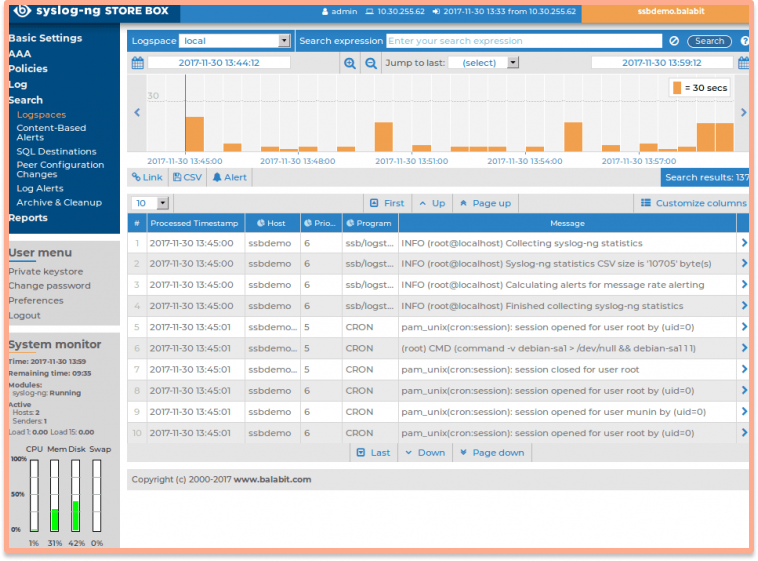
This configuration interface demonstrates syslog-ng's ability to handle complex routing scenarios with multiple sources, transformations, and destinations.
Best For: Enterprise environments, network infrastructure logging, legacy system integration, and organizations requiring high-performance log forwarding with reliability guarantees.
9. OpenSearch - Distributed Search and Analytics
OpenSearch serves as an open source fork of Elasticsearch, providing distributed search and analytics capabilities for log data. While primarily a storage and search engine, it forms the foundation of comprehensive log management solutions.
Key Strengths:
- Powerful Search: Full-text search with complex queries, aggregations, and analytics
- Horizontal Scaling: Distributed architecture scales to handle petabyte-scale datasets
- Rich APIs: Comprehensive REST APIs for integration and custom development
- Security: Built-in authentication, authorization, and encryption capabilities
- Machine Learning: Anomaly detection and pattern recognition for log analysis
OpenSearch Ecosystem:
- OpenSearch Dashboards: Visualization and exploration interface (Kibana alternative)
- Data Prepper: Log processing pipeline for data transformation
- Various Clients: Official clients for multiple programming languages
Performance Characteristics:
- Ingestion: Handles high-volume log ingestion with proper cluster configuration
- Query Performance: Fast search across indexed data with sophisticated caching
- Storage: Optimized storage with compression and tiered storage options
- Scalability: Linear scaling by adding nodes to clusters
Operational Considerations:
- Requires expertise for cluster management and optimization
- Storage and compute resources scale with data volume and query complexity
- Backup and recovery processes are critical for production deployments
- Index management strategies needed for long-term log retention
Best For: Organizations requiring powerful search capabilities, teams with Elasticsearch expertise, and environments needing flexible custom integrations.
10. Logwatch - Simple Log Analysis and Reporting
Logwatch provides straightforward log analysis focused on generating periodic summaries of system logs. Unlike real-time log management systems, Logwatch excels at providing digestible reports for system administrators.
Key Strengths:
- Zero Configuration: Works out-of-the-box on most Linux distributions
- Minimal Resources: Extremely low system impact as it runs periodically rather than continuously
- Security Focus: Excellent for identifying security events and system anomalies
- Email Reports: Automated delivery of log summaries to administrators
- Customizable: Configurable report formats and filtering options
Functionality:
- System Monitoring: Analyzes SSH, kernel, mail, web server, and other common logs
- Security Analysis: Identifies failed login attempts, sudo usage, and suspicious activity
- Report Generation: Produces human-readable summaries with key metrics and alerts
- Scheduling: Runs via cron jobs for daily, weekly, or custom intervals
Typical Use Cases:
- Daily security monitoring for small to medium environments
- Compliance reporting and audit trail generation
- Server health monitoring and maintenance planning
- Complement to real-time monitoring systems
Limitations:
- No real-time alerting or continuous monitoring
- Limited to local log file analysis
- Basic reporting compared to modern analytics platforms
- Not suitable for large-scale or distributed environments
Best For: Small server environments, security-focused monitoring, daily operational reports, and organizations needing simple automated log analysis without complex infrastructure.
Common Pitfalls and How to Avoid Them
Based on real-world deployments, anticipate these critical challenges:
1. Storage Capacity Planning
Problem: ELK stacks frequently run out of storage space, causing system failures and data loss.
Solutions:
- Implement automated storage monitoring with alerts at 70% and 85% capacity
- Configure log retention policies based on business requirements (30-90 days typical)
- Use tiered storage strategies (hot/warm/cold) for cost optimization
- Plan for 3-5x log volume growth year-over-year based on application scaling
2. Resource Underestimation
Problem: "Free" open source tools become expensive due to infrastructure and operational overhead.
Solutions:
- Factor in infrastructure costs including compute (2-4x log volume), storage (3-5x with indexing), and networking
- Budget for operational expertise and training (20-40 hours/month for complex deployments)
- Consider managed services for complex deployments to reduce operational burden
- Start with right-sizing based on actual usage patterns rather than peak theoretical loads
3. Security and Access Control
Problem: Default configurations often lack proper security hardening.
Solutions:
- Enable authentication and authorization from initial deployment
- Implement role-based access controls (RBAC) with least-privilege principles
- Use TLS encryption for all data transmission including internal cluster communication
- Conduct regular security audits and access reviews every 3-6 months
4. Log Quality and Parsing
Problem: Inconsistent log formats significantly impact analysis effectiveness and increase storage costs.
Solutions:
- Standardize log formats across applications using structured logging (JSON preferred)
- Implement centralized logging libraries and standards for development teams
- Create and maintain parsing rule libraries with version control
- Test parsing rules thoroughly in staging environments before production deployment
Technical Requirements Matrix
Now that you've seen the capabilities of each tool, selecting the right log management solution requires careful consideration of your specific requirements, team expertise, and operational constraints. Here's a final takeaway summarizing the key strengths of each tool:
| Requirement | Recommended Tools | Key Considerations |
|---|---|---|
| Unified Observability | SigNoz | Combines logs, metrics, traces in single platform |
| Maximum Search Power | ELK/OpenSearch Stack | Full-text search with complex analytics |
| Cost Optimization | Loki, SigNoz | Label-based indexing, efficient columnar storage |
| High Throughput | Vector, Syslog-ng | Performance-optimized with minimal resource usage |
| Cloud-Native | FluentD/Bit + Loki, SigNoz | Kubernetes-native with auto-discovery |
| Enterprise Features | SigNoz, Graylog, ELK Stack | Security, compliance, enterprise support |
| Simplicity | SigNoz, Logwatch | Easy setup with minimal maintenance overhead |
Get Started with SigNoz
SigNoz provides a modern approach to log management with unified observability, combining logs with metrics and distributed tracing in a single platform. Built on OpenTelemetry standards, it offers vendor-neutral telemetry collection and powerful analytics capabilities.
Key SigNoz logging features include:
- Advanced log query builder with custom quick filters for rapid analysis
- Real-time log streaming and live tail capability for immediate debugging
- Log correlation with traces and metrics for comprehensive system understanding
- OpenTelemetry Collector-based ingestion supporting multiple protocols and formats
- Columnar database backend delivering 2.5x faster queries than Elasticsearch with 50% resource reduction
You can choose between various deployment options in SigNoz. The easiest way to get started with SigNoz is SigNoz cloud. We offer a 30-day free trial account with access to all features.
Those who have data privacy concerns and can't send their data outside their infrastructure can sign up for either enterprise self-hosted or BYOC offering.
Those who have the expertise to manage SigNoz themselves or just want to start with a free self-hosted option can use our community edition.
Hope we answered all your questions regarding open source log management tools. If you have more questions, feel free to join and ask on our slack community.
You can also subscribe to our newsletter for insights from observability nerds at SigNoz — get open source, OpenTelemetry, and devtool-building stories straight to your inbox.
